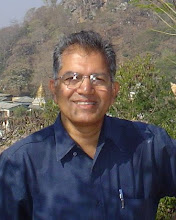Yesterday I received for review from Peter Lang, Sean Doyle's Synthesizing the Vedanta: The Theology of Pierre Johanns, S.J. (2006).
This is a truly welcome book, because up to now Johanns has not received the attention he deserves - even though there have been a few small attempts here and there, as for example the two articles and one book by Mattam.
Johanns was one of the leading lights of the so-called 'Calcutta School' of Catholic, mostly Jesuit, Indologists. The School took its inspiration from Brahmabandhab Upadhyay. William Wallace, SJ, convert from Anglicanism, was impressed by Upadhyay's attempt to Indianize Christianity, and urged his Belgian Jesuit province to set aside gifted men for the study of the Hindu texts. Among the results of this vision were stalwarts like Johanns and Georges Dandoy, co-founders of the innovative monthly The Light of the East.
Johanns' articles on the Vedanta, originally published in The Light of the East, were published in book form by UTC, Bangalore, edited by Theo de Greef, under the inspiration and advice of the later Richard De Smet.
Doyle, who is himself a Protestant and has lived in the US and the UK, helpfully fills in Johanns' background, enabling the contemporary reader to understand just why Johanns was such a great pioneer in the field of the dialogue between Hinduism and Christianity. The one false note is when Doyle keeps calling Johanns a neo-Thomist - unaware that this term is reserved for the likes of Maritain and Gilson. Johanns is better classed as a Transcendental Thomist, or perhaps a Marechalian Thomist. He was certainly influenced by Pierre Scheuer, who De Smet has called a prince among metaphysicians.
In his opinion, Johanns' work has still to be surpassed, in the sense that no Christian has yet given as much attention to the three major strands of Vedanta - Sankara's advaita, Ramanuja's visistadvaita, and Vallabha's suddhadvaita - as Johanns has done. (Strangely, Johanns does not seem to have given as much attention to Madhva's dvaita, which people often assume to be the closest to Christianity.) In fact, according to J. Patmury whom Doyle quotes, Johanns work on Vallabha has still to be surpassed among Christian scholars.
We have to be grateful to Doyle for his path-breaking work on Johanns, marked by competence, thoroughness, openness and fairness. I think we should look forward now to similar work on the other members of the Calcutta School - beginning with Dandoy and De Smet. De Smet has produced a significant body of work on Sankara. Last year, 2010, Motilal Banarsidass brought out a collection of his essays on the personhood of Brahman (Brahman and Person: Essays by Richard De Smet, ed. Ivo Coelho). Currently I am working on a similar collection of his essays on Sankara. Since 2009, Divyadaan: Journal of Philosophy and Education has been serializing De Smet's cyclostyled notes for students, Guidelines in Indian Philosophy; hopefully these too will be made available in book form. Negotiations are on with George McLean, who holds the rights, for the publication of De Smet's doctoral thesis, The Theological Method of Samkara.
